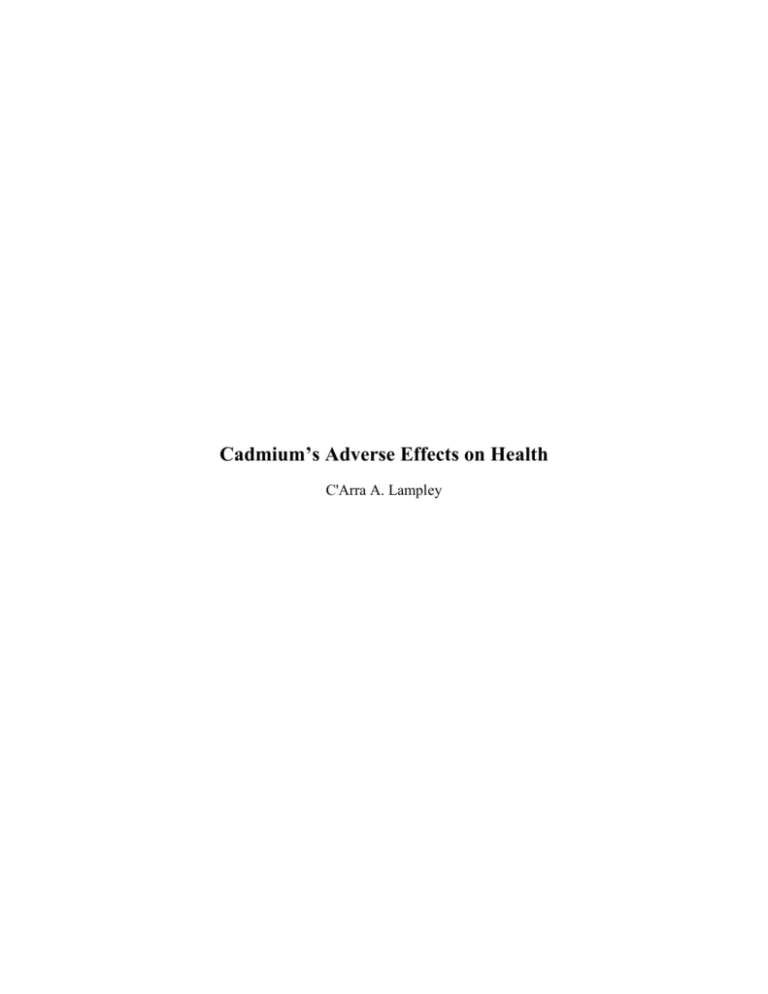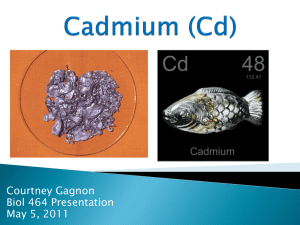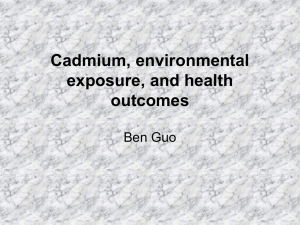SP - NCATCapstone
advertisement

Cadmium’s Adverse Effects on Health C'Arra A. Lampley Introduction The use of fluorescent dyes has greatly improved the understanding of metals in biology. A fluorescent dye is a dye that is visible when highly diluted. They are commonly used as an absorption indicator for metals. Fluorescent dyes are widely used in industry, for example, as a dye in highlighters to give off a glow-like effect and fine arts and design. There are several commercially available fluorescent dyes. These dyes can be used to detect a wide range of metals. The dissociation constant (Kd), or relative affinity of the dye for the metal, is a useful parameter when determining the capability of how well the fluorescent dyes bind to each metal. Dissociation constant is a specific type of equilibrium constant that measures the propensity of a larger object to dissociate reversibly into smaller components, as when a complex falls apart into its component molecules. Zinc is an essential trace element that is vital for development of the body. It is also necessary for the healing of wounds, normal skeletal growth, the improvement of brain function, including memory, and aids in the synthesis of insulin (King 2011). Zinc is found in protein-rich foods such as meat, peanuts and peanut butter, and legumes. Calcium does not exist in nature as a metal, but the divalent calcium cation (Ca2+) in minerals and solutions is common (Nielsen 2009). It is a crucial element that strengthens bones and teeth ensuring that they do not break or fracture easily. In addition, calcium helps maintain total body health, ensures the proper functioning of muscles and nerves, helps blood clotting, regulating blood pressure, and metabolizes iron. Calcium-fortified foods include dairy foods like milk, cheese and yogurt, spinach, almonds and oranges. Unlike zinc and calcium, cadmium (Cd) is not biologically relevant to the body. Cadmium is a toxic metal widely distributed in the environment (Tellez-Plaza, Navas-Acien et al. 2008). Cadmium is regularly found in ores together with zinc, copper and lead. When cadmium is in the body it can be detrimental. It is a nephrotoxic, causing damage to different parts of the body (Gulati, Banerjee et al. 2010). In the general population, the primary sources of cadmium exposure are cigarette smoke, food intake, and ambient air particularly in urban areas and in the vicinity of industrial settings. Women are at greater risk of developing cadmium toxicity than are men (Choudhury, Harvey et al. 2001). An exposure to significantly higher cadmium levels occurs when people smoke (Tellez-Plaza, Navas-Acien et al. 2008). One cigarette contains approximately 1 to 2 μg of cadmium (Kellen, Zeegers et al. 2007). Tobacco smoke transports cadmium into the lungs. Blood will transport it through the rest of the body. Blood cadmium also reflects long-term exposure, but it is more influenced by recent exposure (Nordberg 2006). Other high exposures can occur with people who live near hazardous waste sites or factories that release cadmium into the air and people that work in the metal refinery industry. The respiratory system is affected severely by the inhalation of cadmium-contaminated air: Shortness of breath, lung edema and destruction of mucous membranes as part of cadmium-induced pneumonitis (Godt, Scheidig et al. 2006). Cadmium dispersed in the environment can persist in soils and sediments for decades. When taken up by plants, Cd concentrates along the food chain and ultimately accumulates in the body of people eating contaminated foods (Bernard 2008). Foods that are rich in cadmium can greatly increase the cadmium concentration in human bodies. Examples of these foods include liver, mushrooms, shellfish, mussels, cocoa powder and dried seaweed. The amounts of cadmium ingested daily with food in most countries are in the range of 10 to 20 μg per day (Bernard 2008). Intake of cadmium-contaminated foods can cause acute gastrointestinal effects, such as vomiting and diarrhea (Godt, Scheidig et al. 2006). Studies have demonstrated that cadmium absorbed by inhalation or ingestion can cause irreversible damage to several vital organs, among which the most sensitive are the kidney, the bone and the respiratory tract10. Adverse effects on these organs were described in subjects with relatively high industrial or environmental exposures as compared to the small amounts of cadmium absorbed by the general population (Bernard 2008). Cadmium is poorly absorbed from the gut and only 6% of the ingested dose is taken up by the body, whereas up to 40% is retained in the lung (Dhatrak and Nandi 2009). Cadmium is efficiently retained in the kidney (half-time 10–30 years) and the concentration is proportional to that in urine (Jarup and Akesson 2009). After prolonged and/or high exposure the tubular injury may progress to glomerular damage with decreased glomerular filtration rate, and eventually to renal failure. Likewise, recent data also suggest increased cancer risks and increased mortality in environmentally exposed populations (Jarup and Akesson 2009). Acute exposure to cadmium fumes may cause flu like symptoms including chills, fever, and muscle ache sometimes referred to as "the cadmium blues." Cadmium intake has also shown to be statistically significantly associated with increased risk of endometrial cancer in all women (Akesson, Julin et al. 2008). The prostate is one of the organs with highest levels of cadmium accumulation (Golovine, Makhov et al. 2010). Because of this, prostate cancer is common in men when overexposed to cadmium. Exposure to this heavy metal has been known to cause renal cancer, kidney, and pulmonary damages, and even death. Cadmium overexposure also has an adverse effect on the bones. It has been proposed that cadmium's toxic effect on bone is exerted via impaired activation of vitamin D (Engstrom, Skerving et al. 2009). Cadmium causes damage to the bone, either via a direct effect on bone tissue or indirectly as a result of renal dysfunction. The toxic effect of cadmium on bone became evident at the outbreak of Itai-itai disease in Japan, where severe skeletal damage in women was associated with consumption of heavily cadmium-polluted rice (Kjellstrom 1992). Low-level environmental cadmium exposure promotes osteoporosis and leads to a higher risk of fractures, especially in postmenopausal women (Schutte, Nawrot et al. 2008). Unfortunately there is no effective treatment for cadmium toxicity. Treatments are designed to help manage and relieve symptoms. Common fluorescent dyes used to detect zinc and calcium are FluoZin-3, Calcium Green5N, and Newport Green DCF. Currently, there are no fluorescent dyes uniquely designed to detect cadmium. The purpose of this study was to determine how well current zinc and calcium specific fluorescent dyes would be at detecting cadmium. Materials and Methods All reagents were purchased from Sigma (St. Louis, MO) unless otherwise specified. Experiments were carried out in buffer, which contained (in mM): 140 KCl, 10 MOPS and 10 nitrilotriacetic acid (NTA). The pH of the buffer was adjusted to 7.0 with the addition of potassium hydroxide (KOH), to make more basic, or hydrochloric acid (HCL), to make more acidic. By using the metal chelator NTA, we were able to generate very low free metal concentrations. A metal chelator binds with free metals in a solution and removes them. This allowed us to determine the Kd, or disassociation constant, of dyes for each metal. All 3 metals (ZnSO4, CaCl2 and CdCl2) were diluted from 1000× stock solutions in buffer. To generate 0 µM ‘free’ Zn or Cd levels, the heavy metal chelator TPEN (50 µM) was used to remove any contaminating Zn or Cd from the buffer. To generate 0 µM ‘free’ Ca levels, the chelator EGTA (10 mM) was used. The web-based program MAXCHELATOR (http://www.stanford.edu/$cpatton/maxc.html) was used to determine the concentrations of free metal. The salt forms of FluoZin-3, Newport Green DCF, and Calcium Green-5N were purchased from Invitrogen (Carlsbad, CA) and diluted in buffer to a final concentration of 1 µM in the well. The following additions were made to each well of a 96-well black plate in the precise order: 50 µl of buffer, 25 µl of dye, 25 µl of metal. 96-well black plates were used to avoid cross contamination of fluorescence between adjacent wells. Fluorescence was measured using a PerkinElmer Victor3Vplate reader. For all 3 dyes, parameters were set so that fluorescence was detected upon excitation at 490 nm and emission at 530 nm. Data was collected for each condition 4-6 times a day over a 10 week period. Statistical Analysis Graphs and analyses were completed using GraphPad Prism 4.03 (San Diego, CA). Results Figure 3 is a comparison of calculated Kd values for FluoZin-3 with (A) Zinc (0-6000 µM) and (B) Cadmium (0-9000 µM). Each trace is representative data of experiments repeated at least 3 times. Figure 4 is the determination of Kd of Newport Green DCF with cadmium. This trace is representative data of experiments repeated at least 3 times. Trials done to determine the Kd of Newport Green DCF for zinc were inconclusive because we were not able to achieve higher zinc concentrations in the range of the published Kd. Figure 5 is the comparison of calculated Kd values for Calcium Green-5N with (A) Calcium (0-1500 µM) and (B) Cadmium (0-9000 µM). Each trace is representative data of experiments repeated at least 3 times. Figure 6 is a summary data of dissociation constants of metal-dye interaction. Bars represent mean Kd values ± SE from at least 3 experiments in each condition. Table 1 is a chart of the published Kd values from Invitrogen of fluorescence dyes with zinc, cadmium, and calcium compared to calculated Kd values from this study (ND= Not Determined). Newport Green DCF is a fluorescent dye that was designed to be specific for zinc at low concentrations. However, Newport Green DCF was able to detect cadmium at a higher affinity than zinc, meaning that Newport Green DCF could detect cadmium at lower concentrations than zinc. Calcium Green 5N is a fluorescent dye that was designed to be specific for calcium, yet, it was able to detect cadmium at a higher affinity than calcium. The zinc specific fluorescent dye FluoZin-3 detects cadmium, although at a lower affinity than zinc. Discussion Cadmium is a toxic metal widely distributed in the environment (Nordberg 2006). When cadmium is in the body it can be detrimental. It is a nephrotoxic, causing damage to different parts of the body (Gulati, Banerjee et al. 2010). The primary sources of cadmium exposure are cigarette smoke, food intake, and ambient air particularly in urban areas and in the vicinity of industrial settings. Studies have shown that cadmium absorbed by inhalation or ingestion can cause irreversible damage to several vital organs, among which the most sensitive are the kidney, the bone and the respiratory tract10 (Bernard 2008). Acute exposure to cadmium fumes may cause flu like symptoms including chills, fever, and muscle ache sometimes referred to as "the cadmium blues." Cadmium overexposure also has an adverse effect on the bones. Low-level environmental cadmium exposure promotes osteoporosis and leads to a higher risk of fractures, especially in postmenopausal women (Schutte, Nawrot et al. 2008). Exposure to this heavy metal has been known to cause renal cancer, kidney, and pulmonary damages, and even death. Currently, there are no fluorescent dyes uniquely designed to detect cadmium. By using a novel plate reader assay, we determined how well zinc and calcium selective fluorescent dyes were at detecting cadmium. With the novel plate reader assay, several different concentrations of metals could be tested with each dye at one time. With previous experiments, the disassociation constant was determined by combining one fluorescent dye with one metal concentration at a time. Data from the present study determined that Newport Green DCF and Calcium Green 5N detect cadmium better than the metals that they are specific for. It was further shown thatFluozin-3, although it does detect cadmium, it detects zinc better. The data suggests that an original fluorescent dye could be developed from possibly altering the chemical structures of Newport Green DCF or Calcium Green-5N to be specific for cadmium. Developing an innovative cadmium selective fluorescent dye will make it possible to detect cadmium in living cells and other biological systems. Development of plate reader assay facilitates more data to be collected at a faster pace. The accuracy of this assay was confirmed by comparing dissociation constants for zinc, calcium and cadmium with previously documented values as provided from the Invitrogen website. The average dissociation constants for each dye were almost the same as those published. Using a plate reader assay would be more cost efficient and more effective. Akesson, A., B. Julin, et al. (2008). "Long-term dietary cadmium intake and postmenopausal endometrial cancer incidence: a population-based prospective cohort study." Cancer Res 68(15): 6435-6441. Bernard, A. (2008). "Cadmium & its adverse effects on human health." Indian J Med Res 128(4): 557-564. Choudhury, H., T. Harvey, et al. (2001). "Urinary cadmium elimination as a biomarker of exposure for evaluating a cadmium dietary exposure--biokinetics model." J Toxicol Environ Health A 63(5): 321-350. Dhatrak, S. V. and S. S. Nandi (2009). "Risk assessment of chronic poisoning among Indian metallic miners." Indian J Occup Environ Med 13(2): 60-64. Engstrom, A., S. Skerving, et al. (2009). "Cadmium-induced bone effect is not mediated via low serum 1,25-dihydroxy vitamin D." Environ Res 109(2): 188-192. Godt, J., F. Scheidig, et al. (2006). "The toxicity of cadmium and resulting hazards for human health." J Occup Med Toxicol 1: 22. Golovine, K., P. Makhov, et al. (2010). "Cadmium down-regulates expression of XIAP at the posttranscriptional level in prostate cancer cells through an NF-kappaB-independent, proteasomemediated mechanism." Mol Cancer 9: 183. Gulati, K., B. Banerjee, et al. (2010). "Effects of diesel exhaust, heavy metals and pesticides on various organ systems: possible mechanisms and strategies for prevention and treatment." Indian J Exp Biol 48(7): 710-721. Jarup, L. and A. Akesson (2009). "Current status of cadmium as an environmental health problem." Toxicol Appl Pharmacol 238(3): 201-208. Kellen, E., M. P. Zeegers, et al. (2007). "Blood cadmium may be associated with bladder carcinogenesis: the Belgian case-control study on bladder cancer." Cancer Detect Prev 31(1): 77-82. King, J. C. (2011). "Zinc: an essential but elusive nutrient." Am J Clin Nutr 94(2): 679S-684S. Kjellstrom, T. (1992). "Mechanism and epidemiology of bone effects of cadmium." IARC Sci Publ(118): 301-310. Nielsen, B. G. (2009). "Calcium and the role of motoneuronal doublets in skeletal muscle control." Eur Biophys J 38(2): 159-173. Nordberg, G. F. (2006). "Lung cancer and exposure to environmental cadmium." Lancet Oncol 7(2): 99101. Schutte, R., T. S. Nawrot, et al. (2008). "Bone resorption and environmental exposure to cadmium in women: a population study." Environ Health Perspect 116(6): 777-783. Tellez-Plaza, M., A. Navas-Acien, et al. (2008). "Cadmium exposure and hypertension in the 1999-2004 National Health and Nutrition Examination Survey (NHANES)." Environ Health Perspect 116(1): 51-56.






